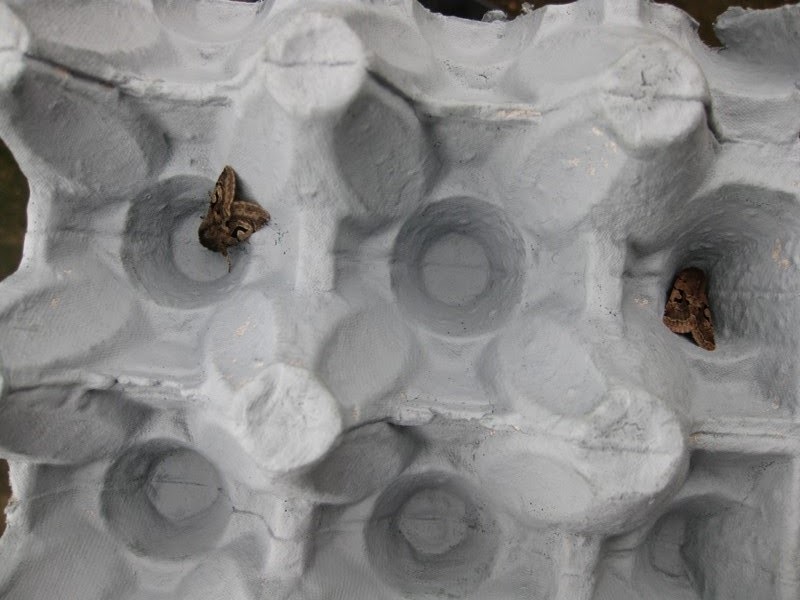I was recently contacted by a moth enthusiast who told me that Butterfly Conservation is undertaking a project to produce an Atlas of moth distribution. They have produced an excellent Butterfly Atlas, which incorporates records from enthusiasts around the UK, and this will follow a similar format. I have therefore been lent this moth trap so that I can help with records from this area.
It is an ingenious home-made device. It is left out over-night. The light attracts the moths and then bounce off it and fall through the funnel-shaped lid. Inside the trap are sections of egg crate and the moths settle down for the night amongst them. In the morning it is just a case of lifting off the lid and checking for moths in the egg crates.
I set the trap up last night for the first time. I wasn't very hopeful, as it was only 5.8 degrees, but this morning I could see one moth through the lid. As I checked through the sections of egg crate I found that I had caught nine moths. They were all Hebrew Characters,
Orthosia gothica.
Once identified, I put the moths in a shed, where they would be safe from the garden birds that were showing an interest in what I was doing!
They may not be as colourful as a butterfly, but I can see that I could get quite hooked on trapping moths. At least it will keep me occupied until the weather warms up enough for the butterflies to start appearing.



That's so interesting. What a clever trap! It sounds like a fun and interesting project....will be interesting to see what all you find.
ReplyDeleteSylvia, I wasn't particularly interested in moths before, but I can see how interesting it should become. I have also been lent a battery so that I can use the trap on a local farm and a nearby nature reserve. However, I have just bought a book and seeing all of the very similar-looking species is a little daunting!!
DeleteThe moth Atlas sound like a smashing idea. I can't wait to see how it turns out.
ReplyDeleteThose little Orthosia moths are lovely!
Best of luck in finding more species.
Jonny, The Atlas should be good, judging by the Millennium Atlas of Butterflies, but I suppose with all of these ideas, they require a lot of people to contribute records to make them more accurate. My wife's cousin lives a couple of miles away in a more rural location and she caught forty moths, of eleven different species on Friday. Apparently numbers should be a lot higher in July.
DeleteNick, are they set lose later? Do you have to document the species by photographing?
ReplyDeleteHi Maria, Yes, you have to be careful not to leave them exposed where birds will find them. I put them into a shed, which has a large ventilation slot. They can then fly off the following evening.
DeleteI have been taking photographs and sending them to the expert who lent me the trap, to make sure that my identification is correct. As I do it for longer I hope that I will be able to identify most of the moths myself, but looking at the book I have just bought, I think I will struggle to identify them all!
That's great, I actually love moths. I would love to see a Hawkmoth someday, there's a species whose larva feeds on tomato plants. It pupates in a burrow in the ground where it's protected.
ReplyDeleteHi Maria, I found an Elephant Hawkmoth a few years ago. I will have to look out the pictures.
DeleteThis is a link to some great pictures of a Hawkmoth
Deletehere
There are also Hummingbird Moths, so I don't know if these are all more or less the same.
Thanks Maria, That is interesting. We have a few Hawkmoths here, but not those ones. I will look out pictures I have.
DeleteActually here there are also a lot of beutiful moths. Will they not die or incapacitated after bumping into the heated light? I am thinking of the mosquito killer in form of a lamp like that! I think i should make an improvised mosquito trap too like that one, you gave me an idea. I just don't know what material to use for the clear cover.
ReplyDeleteI have seen a few more colourful moths around, so I am looking forward to the warmer weather when there should be more moths about. The light runs very cool, as it is incandescent, so the moths are completely unharmed. There is even a drain to prevent rain water from drowning the moths should it rain! I wonder if you could make this into a mosquito trap. Maybe it would have to contain something to kill them, or they would all be flying around inside it. But then any moths that fly into it would also die. Maybe it needs a grille to stop moths getting in. You could have found yourself a new way of making money!!
DeleteThe Orthosia gothica have a nice mosaic pattern of cream, cafe latte, light and dark browns. Btw, I must say that your photography is so good, I can clearly see the whorls on your finger tips :)
ReplyDeleteHi Elsie, I am beginning to appreciate the subtle different shades of brown and patterns on the moths. They are very variable and numerous, so I think it will be some time before I am able to identify them with ease.
DeleteYes, I really should moisturise my hands more often! lol!!